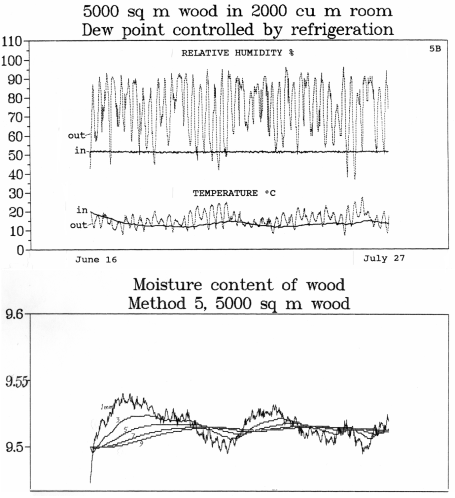
 |
Low energy climate control - 5 |

This method is similar to method 4 except that the air flow is greater so that the room cools below the average ambient temperature. This in turn will require more dehumidification to hold 50% RH. For a given constant air flow the room will settle at 50%RH and at a temperature below ambient which is defined by the competing effects of heat loss and air loss. There are practical complications. The temperature depression requires good air circulation to maintain uniformity in the space. The necessary ducting will carry air at 100% RH, so there will be biological growth in the ducts. In practice therefore, there must be a degree of re-heat after the dehumidification. This will not increase the use of energy, because heat is generated in the cooling equipment. The room temperature will therefore be somewhere between ambient temperature and the temperature shown on this idealised model. This method uses more energy but is better suited to temperature sensitive collections, such as photographs.
This review of ways of controlling relative humidity in rooms filled with absorbent materials shows that relying on moisture buffering alone (method 1) will not work in a humid temperature climate. 'Conservation heating' to constant RH (method 2) is dangerous in a well stuffed room, because the RH may go up or down with rising temperature, so control is impossible. This problem is overcome in method 3 by ignoring the actual room RH and heating to give the correct RH according to the expected outside climate for the time of year. This works well in the well stuffed room but gives an irregular RH in a sparsely filled room, which is better served by method 2. Method 4 overcomes the ambiguity of using RH as the controlling variable by measuring directly the water content of the materials. This can be held constant by heating or by dehumidification. We have chosen to use dehumidification by cooling a small air stream, just enough to maintain a positive pressure, to the required dew point. This controls the humidity without much affecting the temperature. In method 5 we have developed this idea further by passing more than the minimum required air stream through the cooling apparatus, thus reducing the room temperature below the average ambient temperature. This requires more dehumidification, because the dew point is lower for the same RH at a lower temperature. The room settles at a temperature lower than the average ambient temperature. This is scarcely minimum energy climate control, but it is still using less energy than orthodox air conditioning.
We present method 5 to show how computer modelling can be used to predict what happens when the contents of a room are taken into partnership with the climate control apparatus. This is never done in the real world, partly because the engineer has to hand over a building that can be shown to work immediately, even when it is empty, and partly because computer models involving water transport are not regarded (even at the time of this revision, in 2004) as sufficiently reliable for designing buildings.
Our conclusion is that the best low energy method for climate control in store rooms in a temperate climate is to pump into the room an air stream, calculated to be just sufficient to compensate for natural leakage, which passes over a cooling coil whose temperature is controlled by weight changes in a piece of wood, or cotton (or an equivalent value calculated electronically from RH and temperature measurements), so that weight gain causes a lowering of the cooling coil temperature, and thus a lowering of the dew point of the air, and vice versa. A separate air recirculation system holds a uniform (but not constant) temperature throughout the room. It may be necessary to install air filters to absorb pollutants that are not sufficiently diluted by the slow stream of fresh air. The room should be well insulated and sealed against air flow through the walls and around doors and windows. Construction materials should not outgas pollutants. The running cost of this system will be low and the environmental quality will be high.
The quick reaction of orthodox air conditioning systems is unnecessary and wasteful when used to control the sluggishly reacting mass of objects in a museum store. A gentle push towards the right moisture content is all that is needed.
All of these predictions depend on the accuracy of the model. Fortunately for the authors, though unfortunately for the museum, our model was tested in reality and found to be accurate. We describe this unintended test in a sequel to this article
We thank P. Kjærulf-Jensen for fruitful discussions.
The program is based on an extension of the psychrometric equation to low air speeds and to almost dry materials. The wood is assumed to have a layer of air next to it whose relative humdidity is in equilibrium with the moisture content of the wood. The psychrometric wet bulb temperature of this surface layer is assumed to be identical to the wet bulb temperature of the room air outside the boundary layer. If room air and wood are not at equilibrium the boundary layer will have a different RH from the room air but will nevertheless have the same wet bulb temperature. The surface temperature of the wood can therefore be calculated by working the psychrometric equation backwards. The temperature difference between wood surface and room air causes a heat flow which can be calculated from standard formulæ for the heat transfer coefficient. This heat vapourises water from wood. The heat of desorption of water from wood is a function of temperature and of water content.
In this way the water movement through the wood surface can be calculated. The further movement of water through the wood is calculated by applying Fick's law of diffusion between a series of thin layers, each of which is assumed to be of uniform water content. The diffusion constant of water through wood is also a function of temperature and water content.
1. Test reference years are available for much of Europe. They are published by the Commission of the European Communities. Tape or disc can be obtained from the various national meteorological institutions or from: Cenergia ApS, Walgerholm 17, DK-2750 Ballerup, Denmark.
2. The most accessible standard reference work is the Handbook of Fundamentals (metric edition), published by the American Society of Heating, Refrigeration and Air conditioning Engineers (ASHRAE).
3. American Society for Testing and Materials (ASTM) "Standard test methods for moisture content of wood" D 2016-74 (1983).
4. Sarah Staniforth and Bob Hayes, "Temperature and relative humidity measurement and control in National Trust houses," Preprints of the 8th meeting of the ICOM Committee for Conservation, Sydney (1987), 915-926.
5. Raymond H. Lafontaine and Stefan Michalski, "The control of relative humidity - recent developments," Preprints of the 7th meeting of the ICOM Committee for Conservation, Copenhagen 1984, pp 84.17.33-37.
6. Tim Padfield, Martin Burke and David Erhardt, "A cooled display case for George Washington's Commission," Ibid. 84.17.38-42.
7. Sarah Staniforth and Bob Hayes, "Keep the Old Piles standing," New Scientist No 1678, (19 August 1989) 37-41.

This work is licensed under a Creative Commons Attribution-Noncommercial-No Derivative Works 3.0 License.